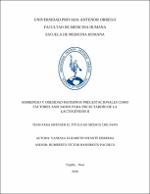| dc.contributor.advisor | Hashimoto Pacheco Humberto Victor | |
| dc.contributor.author | Infante Herrera, Vanessa Elizabeth | |
| dc.creator | Infante Herrera, Vanessa Elizabeth | |
| dc.date.accessioned | 2016-11-21T14:38:45Z | |
| dc.date.available | 2016-11-21T14:38:45Z | |
| dc.date.issued | 2016 | |
| dc.identifier | T_MED_1869 | |
| dc.identifier.uri | https://hdl.handle.net/20.500.12759/2130 | |
| dc.description.abstract | Determinar si existe asociación entre el peso pregestacional materno con
el inicio tardío de la lactogénesis II en las pacientes atendidas en el Hospital II
Tarapoto – EsSalud, Enero – Noviembre del 2015.
Método: Se realizó un estudio prospectivo, analítico, observacional – cohorte y
longitudinal, que evaluó a 56 pacientes, puérperas que acudieron con sus neonatos en
su 3er día de vida, a su tamizaje durante el periodo Enero – Noviembre del 2015. De
los 56 pacientes de estudio, 28 fueron con normopeso y 28 con sobrepeso u obesidad.
Resultados: La paridad es similar en ambos grupos; el promedio de la edad materna
fue de aproximadamente 26 años para ambos grupos (26,36 ± 3,38 años para el grupo
de IMC normal, y 25,93 ± 4,34 años para el grupo con IMC > 25). El peso del recién
nacido de pacientes con IMC pregestacional normal fue 3082,57 ± 381,62 g, a
diferencia de los recién nacidos de madres con IMC > 25 es relativamente superior,
3317,68 ± 381,17 g, lo cual resulta significativo (p < 0,05). Las mujeres con IMC
pregestacional normal tuvieron recién nacidos con Apgar a los 5 min superior que los
recién nacidos de madres con IMC anormal lo cual resulta significativo (p < 0,05).
La producción de leche en 24 h en mujeres con IMC pregestacional normal fue en
promedio de 717,21 ml, pero en las mujeres con IMC pregestacional > 25 en
promedio fue de 376,43 ml; lo cual resulta ser significativo (p < 0,05). Las mujeres
que produjeron menos de 700 ml en 24 h al 3er día post-parto en el grupo de IMC
normal fue de 60,71% y en el grupo de IMC pregestacional > 25 fue de 85,71% lo
cual resulta en significativo (p < 0,05). | es_PE |
| dc.description.abstract | to determinate if there is an association between the maternal prepregnancy
weight and the delayed onset of stage II lactogenesis in patients of the
“Hospital II Tarapoto - EsSalud” during the period January – November 2015.
Methods: we conducted a prospective, analytic, observational – cohort and
longitudinal study, that evaluated 56 patients, women in their 3rd day of postpartum
that came along their newborns for their Screening tests during the period January –
November 2015. From the 56 patients included in the study, 28 were for the group
with normal weight and 28 for the group with overweight or obesity.
Results: parity is similar in both groups; the average age was around 26 years old for
both groups (26,36 ± 3,38 years old for the group with normal BMI, and 25,93 ± 4,34
years old for the group with BMI > 25). The newborn weight from patients with
normal pre-pregnancy BMI was 3082,57 ± 381,62 g, on the other hand, the newborns
from mothers with BMI > 25 was 3317,68 ± 381,17 g, which is significant (p < 0,05).
Women with normal pre-pregnancy BMI had newborns with higher Apgar score in
the 5-minute test than mothers with pre-pregnancy BMI >25 which is significant (p <
0,05). Milk production in 24 h, in women with normal pro-pregnancy BMI was an
average of 717,21 ml, but in women with pre-pregnancy BMI > 25 was 376,43 ml,
which is significant (p < 0,05). Women that produced less than 700 ml in 24 h at the 3 rd day post – partum were the 60,71 % and the group with pre-pregnancy BMI > 25 were the 85,71 % which is significant (p < 0,05). Conclusions: the delayed onset of stage II of lactogenesis is influenced by overweight
and obesity in 85,71 %. | en_US |
| dc.format | application/pdf | es_PE |
| dc.language.iso | spa | es_PE |
| dc.publisher | Universidad Privada Antenor Orrego - UPAO | es_PE |
| dc.rights | info:eu-repo/semantics/openAccess | es_PE |
| dc.source | Repositorio institucional - UPAO | es_PE |
| dc.source | Universidad Privada Antenor Orrego | es_PE |
| dc.subject | Peso Pregestacional | es_PE |
| dc.subject | Lactogenesis | es_PE |
| dc.title | Sobrepeso y obesidad maternos pregestacionales como factores asociados para inicio tardío de la lactogenesis II | es_PE |
| dc.type | info:eu-repo/semantics/bachelorThesis | es_PE |
| thesis.degree.level | Título Profesional | es_PE |
| thesis.degree.grantor | Universidad Privada Antenor Orrego. Facultad de Medicina Humana | es_PE |
| thesis.degree.name | Médico Cirujano | es_PE |
| thesis.degree.discipline | Medicina | es_PE |

